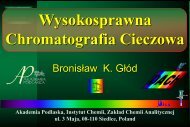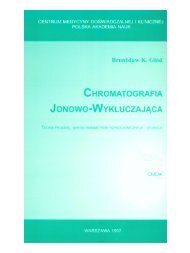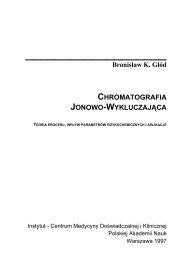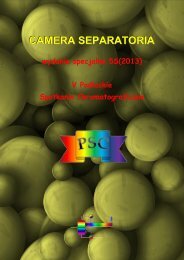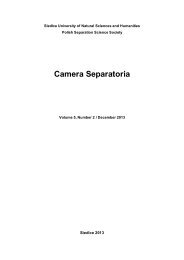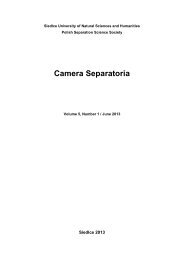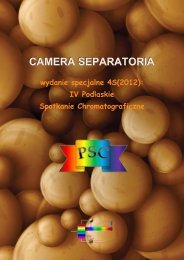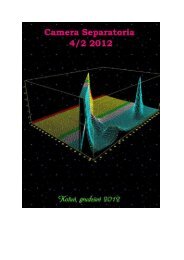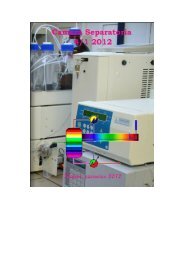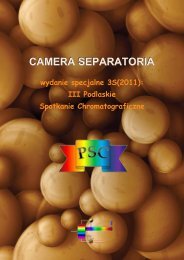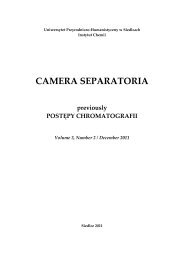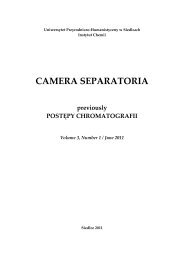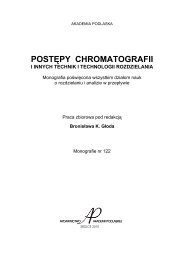CamSep 7 1
Create successful ePaper yourself
Turn your PDF publications into a flip-book with our unique Google optimized e-Paper software.
39<br />
4. Podsumowanie<br />
(Summary)<br />
Wyniki przeprowadzonych badań, wskazują, że zastosowanie modyfikatorów fazy ruchomej w postaci<br />
kwasów przy rozdzielaniu polifenoli z grupy flawonoidów, a także wielu innych organicznych związków<br />
chemicznych zdolnych do odszczepiania protonów w wodzie, jest konieczne w warunkach faz odwróconych<br />
(RP).<br />
Najlepsze wartości parametrów chromatograficznych, które mają wpływ na jakość rozdzielania<br />
substancji, uzyskano - w przypadku kwasów nieorganicznych - dla kwasu siarkowego (VI).<br />
Spośród kwasów organicznych kwas octowy (AcOH) okazał się bardziej korzystny od<br />
trifluorooctowego (TFA). Kwas octowy jest tylko nieco mniej korzystny pod względem wpływu na sprawność<br />
rozdzielania od kwasu siarkowego, natomiast, jego zaletą jest lotność oraz to, że nie jest to kwas mocny.<br />
Pomimo najbardziej korzystnych wyników otrzymanych przy zastosowaniu kwasu siarkowego<br />
(tj. pod względem symetrii pików oraz liczby półek teoretycznych), do wydzielania rozdzielanych polifenoli w<br />
skali preparatywnej, bardziej praktyczne może być użycie kwasu octowego. Jest on bardziej lotny, co<br />
umożliwia łatwiejsze usunięcie go z otrzymanych frakcji i jest nie jest mocnym kwasem, co zapewnia brak<br />
"destrukcyjnego" działania w warunkach podwyższonej zawartości w okresie wzbogacania frakcji eluatu.<br />
Results of this study indicate that the use of mobile phase modifiers, in the form of acids is necessary,<br />
when polyphenols (from the group of flavanoids) and many organic compounds capable to cleveage of<br />
protons in water under reversed phase (RP) conditions are separated.<br />
In the case of inorganic acids, the best values of chromatographic parameters (affecting the quality of<br />
the separation) were obtained with sulfuric acid (VI).<br />
Among the organic acids, the addition of acetic acid (AcOH) proved to be more advantageous than<br />
trifluoroacetic (TFA). Acetic acid, in comparison to the sulfuric acid, is less preferred in terms of its impact on<br />
the efficiency of separation. However, its advantage is volatility and the fact, that AcA is not a strong acid.<br />
Although the most favorable results obtained using sulfuric acid (i.e. symmetry of peaks, number of<br />
theoretical plates), separation and isolation in preparative scale of polyphenols, may be more practical with<br />
AcA. As mentioned above, acetic acid is more volatile, which makes it easier to remove from obtained<br />
fractions. Additionally, acetic acid is not a strong acid, which provides no “destructive” influence under its<br />
elevated content during enrichment of eluate fractions.<br />
Literatura<br />
(References)<br />
[1] B.A. Graf, P.E. Milbury, J.B. Blumberg, Flavonols, flavones, flavanones, and human health:<br />
Epidemiological evidence, Journal of Medicinal Food 8 (2005) 281<br />
[2] D. Chen, S.B. Wan, H. Yang, J. Yuan, T.H. Chan, Q.P. Dou, Chapter 7 – EGCG, green tea<br />
polyphenols and their synthetic analogs and prodrugs for human cancer prevention and treatment ,<br />
Advances in Clinical Chemistry 53 (2011) 155<br />
[3] I. Erlud, Review of the flavonoids quercetin, hesperetin, and narigenin. Dietary sources, bioactivities,<br />
bioavailability, and epidemiology, Nutrition Research 24 (2004) 851<br />
[4] Y. Liu, P. Wang, F. Chen, Y. Yuan, Y. Zhu, H. Xan, X. Hu, Role of plant polyphenols in acrylamide<br />
formation and elimination, Food Chemistry 186 (2015) 46<br />
[5] S. Gouveia, P.C. Castilho, Characterisation of phenolic acid derivatives and flavonoids from different<br />
morphological parts of Helichrysum obconicum by a RP -HPLC-DAD-(-)-ESI-MS n method, Food<br />
Chemistry 129 (2011) 333<br />
[6] D. Romanova, D. Grancai, B. Jozova, P. Bozek, A. Vachalkova, Determination of apigenin in rat<br />
plasma by high-performance liquid chromatography, Journal of Chromatography A 870 (2000) 463<br />
[7] F.L. Vigni, C. Baschieri, A. Marchetti, M. Cocchi, RP-HPLC and chemometrics for wheat flour protein<br />
characterization in an industrial bread-making process monitoring context, Food Chemistry 139 (2013)<br />
553<br />
[8] F. Khuda, Z. Iqbal, Y. Shah, L. Ahmmad, F. Nasir, A.Z. Khan, Amanullah, N. Shahbaz, Method<br />
development and validation for simultaneous determination of lumefantrine and its major metabolite,<br />
desbutyl lumefantrine in human plasma using RP -HPLC/UV detection, Journal of Chromatography B<br />
944 (2014) 114<br />
[9] K.R. Naidu, U.N. Kale, M.S. Shingare, Stability indicating RP-HPLC method for simultaneous<br />
determination of amlodipine and benazepril hydrochloride from their combinationdrug product, Journal<br />
of Pharmaceutical and Biomedical Analysis 39 (2005) 147<br />
Vol. 7, No 1/2015<br />
Camera Separatoria




